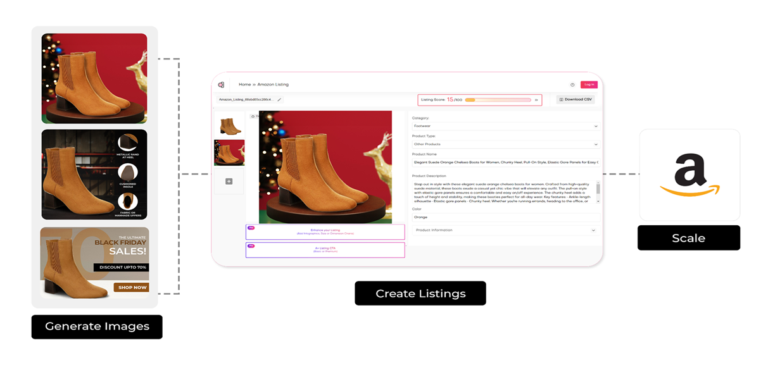Meet our contributing author, a representative of Dresma, a SaaS platform dedicated to helping online brands of all sizes create high-impact, sales-driven content like Amazon product photography.

Nishka Sinha
As the Co-founder & CMO of Dresma, a Silicon Valley-based start-up, she is on a mission to disrupt the way visual content for online selling is created.
Dresma has developed the all-in-one AI-powered platform Dresma and the DoMyShoot mobile app, a self-use solution for online sellers to custom generate professional eCommerce images instantly at unprecedented scale & low cost.
In the current digital marketplace, product photography is crucial for e-commerce success. Recent analytics from BigCommerce reveal that product images are the leading factor influencing purchase decisions, with professional photography potentially boosting conversion rates by up to 30% compared to non-professional images.
For Amazon sellers, adopting professional photography standards transcends mere aesthetics; it represents a vital business investment that can significantly affect profitability. Whether working independently or collaborating with an Amazon agency, sellers must adhere to Amazon’s strict image requirements, mandating high-resolution images set against a pure white background to maintain clarity and uniformity across listings.
Investing in professional photography not only bolsters brand credibility but also enhances visibility and boosts sales performance.
Table of Contents
Importance of Amazon Product Photography
Incorporating high-quality Amazon product photography into your product listings can significantly boost sales by:
1. Capturing Attention
High-resolution, professional images stand out in search results, increasing the likelihood of clicks and engagement.
2. Building Trust
Clear and detailed photos convey transparency and reliability, fostering customer confidence in your product’s quality.
3. Highlighting Features
Images showcasing multiple angles and close-ups provide comprehensive insights into the product’s features, helping customers make informed decisions.
4. Enhancing Brand Perception
Consistent and polished visuals reflect a professional brand image, increasing perceived value and encouraging customer loyalty.
By focusing on these aspects, Amazon sellers can effectively leverage product photography to drive higher engagement and sales.
Understanding Amazon's Image Requirements
Amazon maintains strict guidelines for product photography to ensure consistency and quality across its platform. Primary product images must meet specific technical criteria to maintain listing compliance and optimize visibility.
Success on Amazon’s platform begins with a thorough understanding of their specific image requirements. These guidelines ensure consistency across the marketplace while optimizing the customer shopping experience.
Technical Specifications
Amazon maintains strict technical requirements for product images to ensure optimal display across various devices and enable features like zoom functionality. The platform accepts multiple file formats, including JPEG, PNG, and TIFF.
However, JPEG remains the preferred format due to its optimal balance of quality and file size. For organizational efficiency, implement a systematic naming convention using product identification numbers.
When preparing images, implement a systematic naming convention incorporating product identification numbers to streamline inventory management and listing updates. Primary product images must maintain a minimum resolution of 1000 pixels on the longest side, with professional sellers often opting for 2000+ pixels to future-proof their listings and accommodate high-resolution displays.
Compliance Guidelines
Main product images must feature a pure white background (#FFFFFF) to meet listing standards. This guideline ensures consistency in visuals across the marketplace and improves the product’s visibility.
Amazon does not allow extra text, logos, or watermarks on primary images; however, these elements can be included in secondary images if they follow certain guidelines.
Secondary images should highlight product features, usage scenarios, and dimension details while complying with Amazon’s content policies.
While primary images must remain free of additional elements, secondary images offer more flexibility for showcasing product features, usage scenarios, and dimensional information.
Dropping sales?
Hidden image suppression could be the culprit. Watch this video to fix it before it kills your traffic.
Essential Photography Equipment
Creating high-quality product images requires appropriate equipment selection based on your business scale and budget considerations. Yes, solutions exist for various budget levels.
Camera Equipment
Professional-grade product photography typically employs DSLR or mirrorless cameras equipped with appropriate lenses.
However, modern smartphone cameras with proper lighting and stabilization can produce acceptable results for sellers beginning their e-commerce journey.
Here’s a brief:
DSLR Cameras
- Offer excellent image quality and control
- Provide compatibility with specialized lenses
- Enable tethered shooting for immediate review
- Feature robust manual controls for precise adjustments
Mirrorless Cameras
- Deliver comparable quality in compact form factors
- Provide silent operation for studio environments
- Often include advanced focus assistance features
- Typically offer better video capabilities for multimedia content
Lens Selection
Choose lenses based on your product category and shooting requirements:
- 50mm prime lenses excel at general product photography
- 85mm lenses provide flattering perspectives for fashion items
- Macro lenses capture intricate details for small products
- 24-70mm zoom lenses offer versatility for varied product sizes
Lighting Solutions
Professional lighting significantly impacts image quality and consistency:
Primary Lighting:
- Continuous LED panels provide consistent illumination
- Strobes offer powerful output for larger products
- Softboxes ensure even light distribution
- Light tents simplify small product photography
Secondary Lighting:
- Fill lights eliminate harsh shadows
- Strip lights provide edge definition
- Reflectors offer cost-effective light control
- Diffusion materials ensure even illumination
Essential Accessories
Quality product photography requires:
- Sturdy tripod for stability and consistent framing
- White backdrop material meeting Amazon’s background requirements
- Color calibration tools for accurate product representation
- Camera remote or timer to prevent motion blur
Professional Photography Techniques
Implementing professional photography techniques ensures consistent, high-quality product images that meet Amazon’s requirements while engaging potential customers.
Composition Fundamentals
Product positioning should emphasize key features while maintaining clear sight lines. Implement the rule of thirds for dynamic composition, particularly in lifestyle and contextual shots. Maintain consistent product orientation across all images to provide coherent visual navigation.
- Implementation of the rule of thirds for dynamic composition
- Consistent product orientation across all images
- Strategic use of negative space
- Balanced visual weight distribution
Lighting Implementation
Position primary lighting at 45 degrees to the product, using fill lights to eliminate harsh shadows. For reflective products, employ polarizing filters or adjusted light positioning to minimize unwanted glare. Document lighting setups to maintain consistency across product lines.
- Position main lights at 45 degrees to the product
- Utilize fill lights to eliminate harsh shadows
- Implement backlighting for product separation
- Control reflections on glossy surfaces
- Document lighting setups for consistency
Advanced Capture Techniques
Maximize image quality through proper capture procedures:
- Utilize manual camera settings for consistent results
- Implement focus stacking for enhanced depth of field
- Capture multiple exposures for dynamic range control
- Maintain consistent color temperature
- Enable lens corrections in camera
Post-Production Workflow
Professional post-production ensures images meet Amazon’s technical requirements while maintaining visual appeal.
Initial Processing
- Raw file conversion
- Color correction
- Exposure adjustment
- Lens distortion correction
- Perspective alignment
Image Optimization
- Color correction for accurate product representation
- Background cleanup to meet pure white requirements
- Size and format optimization for Amazon’s specifications
- Quality control review against Amazon’s guidelines
Quality Control
- Resolution verification
- Color accuracy assessment
- Background consistency check
- Format specification review
- File size optimization
Batch Processing
Implement standardized processing procedures for consistency across product lines. Maintain original files separately from web-optimized versions, enabling future adjustments if needed.
Common Technical Challenges
Understanding and avoiding common technical issues ensures consistent listing compliance and optimal presentation.
Technical Issues
Address common technical challenges proactively:
- Color balance across lighting conditions
- Scale representation consistency
- Shadow and reflection control
- Focus and depth of field management
- File size optimization
Workflow Optimization
Streamline production processes through:
- Batch processing procedures
- Automated file naming conventions
- Standardized editing presets
- Version control systems
- Regular equipment calibration
Troubleshooting
Address common issues proactively:
- Correct color balance across different lighting conditions
- Maintain consistent scale representation
- Eliminate shadows and reflections
- Ensure proper focus and depth of field
Optimizing Product Photography for Amazon Prime Day Success
As Amazon Prime Day approaches, sellers must ensure their product listings are primed to attract the surge of eager shoppers. A critical component of this preparation is high-quality product photography.
Professional images not only capture attention but also build trust and convey the value of your products. It’s advisable to update your product listings with compelling visuals at least three weeks before the event.
By investing in top-tier photography, you position your products to stand out during this competitive period, ultimately driving higher engagement and sales.
Case Study: Amazon More Enhances In-Store Product Photography with Dresma
Amazon More, a prominent eCommerce platform in India, faced challenges in their in-store product photography for the FMCG sector.
The process required extensive coordination among teams, leading to delays and logistical issues. Additionally, inconsistent image quality due to varying equipment and lighting conditions affected the overall presentation.
Dresma addressed these issues by implementing a pre-configured workflow. This solution empowered in-store staff to capture high-quality images using mobile devices, reducing the need for specialized equipment and streamlining the process.
Dresma’s AI-powered editing ensured consistent lighting, background removal, and formatting. This resulted in uniform and professional images across all products.
The collaboration led to faster turnaround times as images were delivered within 24 hours. This case underscores the importance of leveraging advanced photography solutions to maintain high standards in product presentation, ultimately enhancing customer experience and driving sales.
Conclusion
Professional Amazon product photography represents a critical investment in your e-commerce success. Effective Amazon product photography requires a balanced approach to technical compliance and visual appeal. By adhering to Amazon’s guidelines, sellers can create compelling product presentations that drive customer engagement and sales conversion.
Key Takeaways:
- Invest in appropriate equipment based on your business scale
- Master Amazon’s technical requirements for consistent compliance
- Implement systematic workflows for efficient production
- Maintain rigorous quality control standards
- Document processes for consistent results
Begin elevating your Amazon listings today by implementing these professional photography techniques. Start with a single product line to refine your workflow. Scale your processes across your entire catalog. Remember, professional product photography isn’t just about creating beautiful images—it’s about driving real business results through enhanced visual presentation.





